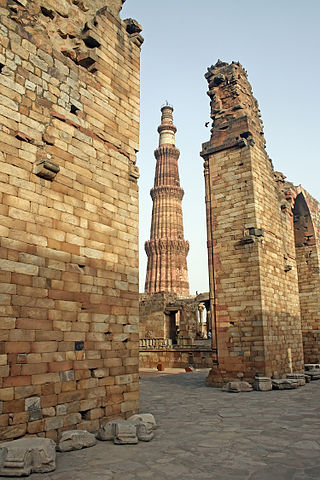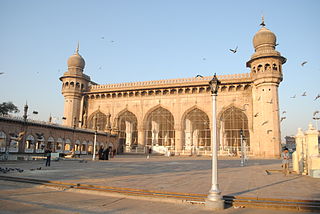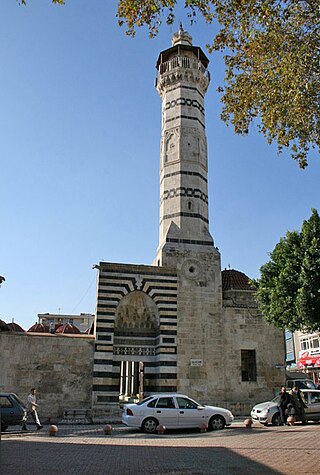
The Prophet's Mosque is the second mosque built by the Islamic prophet Muhammad in Medina, after the Quba Mosque, as well as the second largest mosque and holiest site in Islam, after the Masjid al-Haram in Mecca, in the Saudi region of the Hejaz. The mosque is located at the heart of Medina, and is a major site of pilgrimage that falls under the purview of the Custodian of the Two Holy Mosques.

The Qutb Minar complex are monuments and buildings from the Delhi Sultanate at Mehrauli in Delhi, India. Construction of the Qutub Minar "victory tower" in the complex, named after the religious figure Sufi Saint Khwaja Qutbuddin Bakhtiar Kaki, was begun by Qutb-ud-din Aibak, who later became the first Sultan of Delhi of the Mamluk dynasty. It was continued by his successor Iltutmish, and finally completed much later by Firoz Shah Tughlaq, a Sultan of Delhi from the Tughlaq dynasty (1320–1412) in 1368 AD. The Qubbat-ul-Islam Mosque, later corrupted into Quwwat-ul Islam, stands next to the Qutb Minar.

The Quba Mosque is a mosque located in Medina, in the Hejaz region of Saudi Arabia, first built in the lifetime of the Islamic prophet Muhammad in the 7th century C.E. It is thought to be the first mosque in the world, established on the first day of Muhammad's emigration to Medina. Its first stone is said to have been laid by the prophet, and the structure completed by his companions. The mosque was subsequently modified across the centuries until the 1980s, when it was completely replaced by a new building that stands today.

The Masjid-i-Jehan-Numa, commonly known as the Jama Masjid of Delhi, is one of the largest mosques in India.

Mughal architecture is the type of Indo-Islamic architecture developed by the Mughals in the 16th, 17th and 18th centuries throughout the ever-changing extent of their empire in the Indian subcontinent. It developed from the architectural styles of earlier Muslim dynasties in India and from Iranian and Central Asian architectural traditions, particularly Timurid architecture. It also further incorporated and syncretized influences from wider Indian architecture, especially during the reign of Akbar. Mughal buildings have a uniform pattern of structure and character, including large bulbous domes, slender minarets at the corners, massive halls, large vaulted gateways, and delicate ornamentation; examples of the style can be found in modern-day Afghanistan, Bangladesh, India and Pakistan.

The Moti Masjid is a 17th-century mosque inside the Red Fort complex in Delhi, India. It was built by Mughal emperor Aurangzeb, damaged during the Siege of Delhi, and subsequently restored by the British. Named for its white marble, the mosque features ornate floral carvings. It is an important example of Mughal architecture during Aurangzeb's reign.

Makkah Masjid or Mecca Masjid, is a congregational mosque in Hyderabad, India. It is the largest mosque in the city, and one of the largest in the country, with a capacity of 10,000 people. The mosque was built during the 17th century, and is a state-protected monument. It serves as the primary mosque for the Old City of Hyderabad, and is located close to the historic landmarks of Charminar, Chowmahalla Palace and Laad Bazaar.

Indo-Islamic architecture is the architecture of the Indian subcontinent produced by and for Islamic patrons and purposes. Despite an initial Arab presence in Sindh, the development of Indo-Islamic architecture began in earnest with the establishment of Delhi as the capital of the Ghurid dynasty in 1193. Succeeding the Ghurids was the Delhi Sultanate, a series of Central Asian dynasties that consolidated much of North, East, and Central India, and later by the Mughal Empire during the early 16th century. Both of these dynasties introduced Islamic architecture and art styles from West Asia into the Indian subcontinent.

The Great Mosque of Adana, also known as the Ramazanoglu Mosque, is a mosque from the 16th century in Adana, Turkey. It forms part of a complex (külliye) that includes a madrasah and a mausoleum (türbe). The complex is on Kızılay Street, next to the Ramazanoğlu Hall.

Moth ki Mosque is a heritage building located in Delhi, and was built in 1505 by Wazir Miya Bhoiya, Prime Minister during the reign of Sikander Lodi (1489–1517) of the Lodi dynasty. It was a new type of mosque developed by the Lodis in the fourth city of the medieval Delhi of the Delhi Sultanate. The name of the mosque literally translated into English language means ‘Lentil Mosque’ and this name tag ‘Lentil’ has an interesting legend. This mosque was considered a beautiful Dome (Gumbad) structure of the period.

Jahanpanah was the fourth medieval city of Delhi established in 1326–1327 by Muhammad bin Tughlaq of the Delhi Sultanate. To counter the persistent threat of Mongol invasions, Tughlaq constructed the fortified city of Jahanpanah, incorporating the Adilabad Fort, built in the 14th century, along with all the establishments located between Qila Rai Pithora and Siri Fort. Neither the city nor the fort has survived. Many reasons have been offered for such a situation. One of these is exemplified by the idiosyncratic rule of Mohammed bin Tughlaq, who inexplicably decreed the capital to be moved to Daulatabad in the Deccan, only to return to Delhi soon after.

Jama Masjid, also known as Jumah Mosque or Jami' Masjid, is a mosque in Ahmedabad, Gujarat, India. It was built in 1424 during the reign of Ahmad Shah I. The inscription on the central mihrab commemorates the inauguration of the mosque on the 1st Safar A.H. 827 or January 4, 1424 A.D. by Sultan Ahmad Shah I. The mosque lies in the old walled city, and it is situated outside Bhadra Fort area. The old walled city is divided into separate quarters or pols, and the Jami' Masjid is found on the Gandhi Road. Along the south side of the road, the mosque is a short distance beyond the Teen Darwaza or Tripolia Gate.

The Badshahi Mosque is a Mughal-era imperial mosque located in Lahore, Punjab, Pakistan. It was constructed between 1671 and 1673 during the rule of Aurangzeb, opposite of the Lahore Fort on the northern outskirts of the historic Walled City. It is widely considered to be one of the most iconic landmarks of the Punjab.

There are eleven different types of buildings at the UNESCO-protected Champaner-Pavagadh Archaeological Park in Gujarat, India, including mosques, temples, granaries, tombs, wells, walls, and terraces. The monuments are situated at the foot of and around the Pavagadh Hill. The Baroda Heritage Trust lists 114 monuments in the area, of which only 39 are maintained by the Archaeological Survey of India, due to limited funding. The Forest Department owns 94% of the land here, while the temple trusts and other sectarian establishments provide facilities for boarding and lodging to pilgrims and tourists. On the southern side near the foot of the hill some dilapidated houses and the foundations of Jain temples can also be seen.

The Sunehri Masjid is an 18th-century mosque in Old Delhi. It was built by Mughal noble Roshan-ud-Daula, during the reign of Mughal Emperor Muhammad Shah. It is located near the Gurudwara Sis Ganj Sahib in Chandni Chowk, once an imperial boulevard leading to the Red Fort.

Qila-i-Kuhna Mosque is a mosque located inside the premises of Purana Qila in Delhi, the capital of India.

Bara Gumbad is a medieval monument located in Lodhi Gardens in Delhi, India. It is part of a group of monuments that include a Friday mosque and the "mehman khana" of Sikandar Lodhi, the ruler of the Delhi Sultanate. The Bara Gumbad was constructed in 1490 CE, during the reign of the Lodhi dynasty. Its construction is generally attributed to Sikandar Lodhi, and it is believed to have the earliest constructed full dome of any building in Delhi.

İskender Pasha Mosque, a.k.a. Terkim Masjid is a historic mosque located in Fatih district in Istanbul, Turkey.

The tomb of the noble Isa Khan Niazi is located in the Humayun's Tomb complex in Delhi, India. The mausoleum, octagonal in shape and built mainly of red sandstone, was built in 1547–1548 during the reign of Sher Shah Suri. The mosque of Isa Khan is located west of the mausoleum, which along with other buildings form the UNESCO World Heritage Site of Humayun's tomb complex.

The Zeenat-ul-Masajid, also written as Zeenat-ul-Masjid and popularly known as the Ghata Masjid, is an 18th-century Mughal mosque located in Delhi, India. The mosque was commissioned by Zeenat-un-Nissa, second daughter of the Mughal emperor Aurangzeb.






















